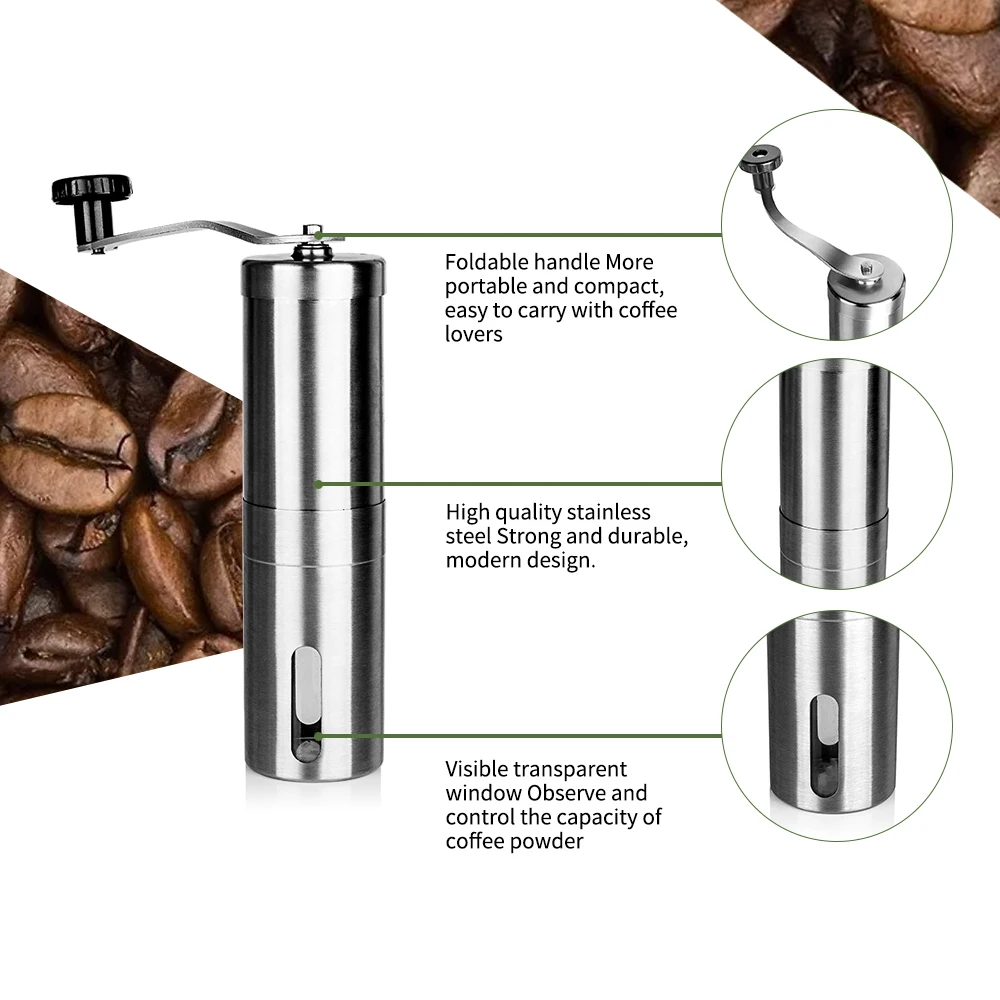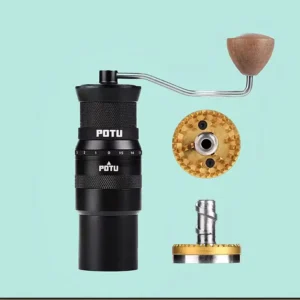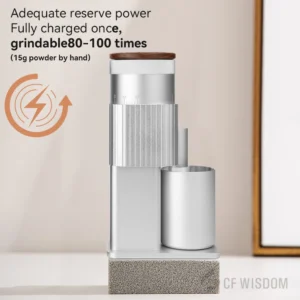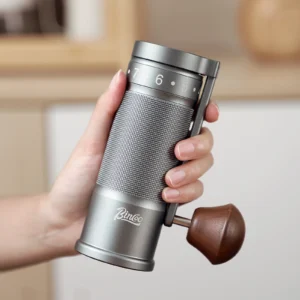Understanding the Importance of Fresh Ground Coffee While Traveling
For coffee enthusiasts, there’s nothing quite like the experience of freshly ground coffee. That first whiff of aromatic beans being transformed into grounds moments before brewing creates an experience that pre-ground coffee simply cannot match. This difference becomes even more significant when you’re traveling and craving that perfect cup away from home.
Fresh ground coffee refers to beans that are ground immediately before brewing. This timing is crucial because coffee beans contain hundreds of aromatic compounds and oils that begin to degrade the moment grinding occurs. The science is clear – when coffee is ground, its surface area increases dramatically, exposing these delicate compounds to oxygen. This oxidation process happens remarkably quickly, with studies showing that coffee loses up to 60% of its aromatic compounds within just 15 minutes of grinding.
The flavor distinction between pre-ground and freshly ground coffee isn’t subtle. Pre-ground coffee often delivers a flat, one-dimensional taste profile, while freshly ground coffee provides a complex symphony of flavors – from fruity and floral notes to chocolate and nutty undertones. Professional coffee tasters consistently rate freshly ground coffee significantly higher in sensory evaluations, noting superior aroma, flavor clarity, and mouthfeel.
For travelers who love quality coffee, this presents a particular challenge. How do you maintain this freshness standard while dealing with limited luggage space, varying accommodations, and being far from your home setup? This is where portable coffee grinder solutions become essential, allowing coffee lovers to enjoy the full sensory experience of fresh coffee anywhere in the world.
The benefits of manual grinders for portable perfection are especially notable for travelers, as they bridge the gap between convenience and quality. By understanding why fresh grinding matters, you can make more informed decisions about which travel grinding solution might best suit your coffee needs on the road.
Essential Features of Travel-Friendly Coffee Grinders
When selecting a coffee grinder for travel, several key features can make the difference between a frustrating experience and coffee perfection on the go. Understanding these elements will help you make an informed decision about which grinder best suits your travel style.
Size and Weight
The ideal travel grinder should be compact enough to fit easily in a backpack or suitcase without consuming valuable space. Many quality travel grinders are designed to nest inside popular brewing devices like the AeroPress, effectively saving space by combining storage. Weight is equally crucial – a grinder that’s too heavy will quickly become burdensome during extended travel.
Build Quality and Durability
Travel conditions can be rough on equipment, making durability paramount. Look for grinders constructed from high-quality materials like aircraft-grade aluminum, stainless steel, or impact-resistant polymers that can withstand being jostled in luggage or backpacks. Drop-resistant designs and protective cases offer additional security.
Grind Consistency
Perhaps the most crucial feature for coffee quality is grind consistency. This is where the distinction between burr grinders and blade grinders becomes critical. Burr grinders crush beans between two textured surfaces set at precise distances, creating uniformly sized particles essential for even extraction. Blade grinders, which simply chop beans randomly, produce inconsistent grounds with both fine powder and larger chunks, leading to uneven extraction and inferior coffee.
The essential features of compact coffee grinders include considerations about burr material and design. Steel burrs generally offer greater longevity and precision for travelers, while ceramic burrs can be lighter but more fragile. Conical burrs are most common in portable grinders, providing excellent consistency while keeping the design compact.
Grind Adjustability
Different brewing methods require different grind sizes – fine for espresso, medium for pour-over, and coarse for French press. A quality travel grinder should offer easily adjustable settings with clear, repeatable steps or clicks that allow you to switch between brewing methods during your journey.
Capacity Considerations
While smaller capacity means a more compact grinder, it also means grinding multiple batches for larger brews. The sweet spot for most travelers is a grinder that can handle 20-30 grams at once—enough for one to two cups without requiring multiple grinding sessions.
Maintenance on the Go
Look for models that disassemble easily for cleaning without tools. Some quiet travel-friendly grinders feature design elements that minimize the grounds that get stuck in crevices, making quick cleaning possible even with limited resources.
The best travel coffee grinder options balance all these features with personal priority factors. Some travelers prioritize absolute minimum size, while others may accept slightly larger dimensions for superior grind quality or easier adjustment.
Manual Travel Grinders: The Ultimate in Portability
Manual coffee grinders represent the ideal solution for many travelers seeking fresh coffee on the go. These hand-powered devices typically consist of a chamber for beans, an adjustable burr grinding mechanism, and a handle that provides the rotation necessary to grind the coffee.
The advantages of manual grinders for travelers are substantial. Their most obvious benefit is complete independence from power sources – you can grind coffee atop a mountain, deep in the wilderness, or in a hotel room without worrying about outlets or battery life. Most manual options are remarkably compact and lightweight, often weighing less than 12 ounces and taking up minimal space in luggage. Their simple mechanical design also means there are fewer parts that can break, making them highly durable under travel conditions. As an added bonus, manual grinders operate quietly – perfect for early mornings in shared accommodations when others might still be sleeping.
Of course, there are trade-offs to consider. Manual grinding requires physical effort, typically taking 1-3 minutes of cranking to produce enough grounds for a cup or two. This time commitment might feel significant when you’re eager for that first morning cup. Most portable models also have limited capacity, typically holding enough beans for just 1-2 servings, meaning multiple grinding sessions for group brewing.
Manual grinders truly excel in specific travel scenarios. They’re perfect companions for wilderness backpacking, international travel where power adaptors might be an issue, or situations where noise considerations are important. Their reliable performance regardless of external factors makes them particularly valuable for manual coffee burr grinders enthusiasts who want consistency wherever their travels take them.
Premium Manual Grinders for Discerning Coffee Travelers
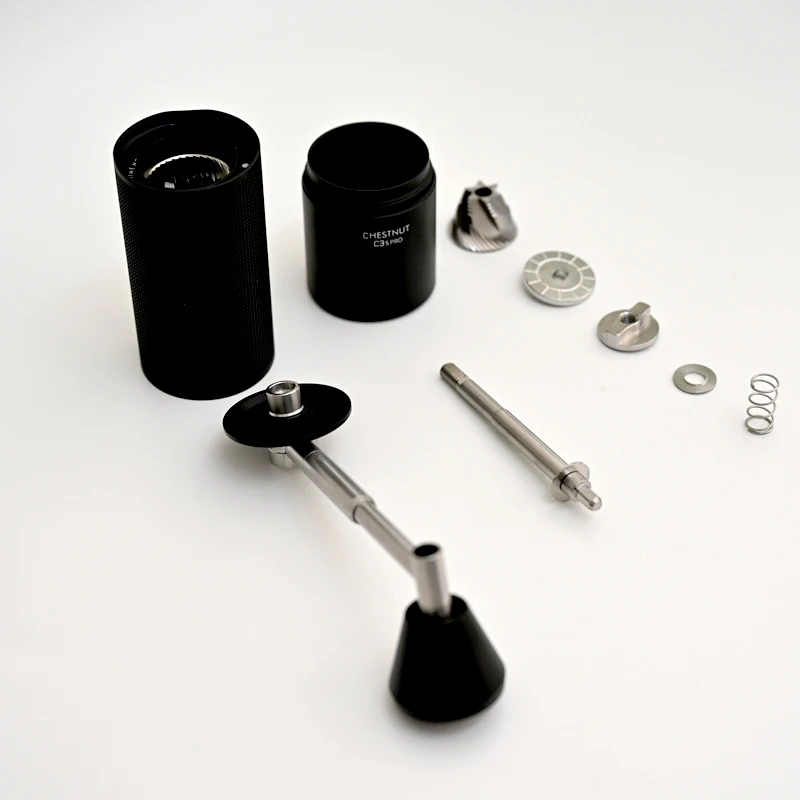
For coffee enthusiasts who refuse to compromise on quality even while traveling, premium manual grinders offer exceptional performance in portable packages. These high-end options combine precision engineering with durable materials to deliver home-quality grinding anywhere your journey takes you.
1Zpresso K-Ultra/J-Ultra
The 1Zpresso Ultra series represents the pinnacle of portable grinding technology. Housed in a sleek aluminum body weighing approximately 24 ounces, these grinders feature professional-grade 48mm steel burrs that produce remarkably consistent grounds across all settings.
Pros:
– Exceptional grind consistency rivaling high-end electric home grinders
– 90+ easily distinguished adjustment points allow precise dial-in for any brewing method
– Smooth, effortless grinding action requires minimal effort
– Generous 30-35g capacity suitable for multiple servings
– External adjustment ring with clear numbering system makes repeatable settings easy
Cons:
– Higher price point ($200+)
– Slightly heavier than more basic travel options
– Larger diameter may not fit inside some brewing devices
Comandante C40 Mk4
Handcrafted in Germany, the Comandante has achieved cult status among coffee professionals for its exceptional build quality and performance. Its distinctive design features a glass collection jar and wooden handle that add visual appeal to its functional excellence.
Pros:
– Consistently produces competition-quality grounds with minimal fines
– Unique high-nitrogen stainless steel burrs deliver clean, bright flavor profiles
– Calibrated “clicks” system provides repeatable precision
– Available accessories include replacement jars and travel cases
– Exceptional durability with serviceable design for years of use
Cons:
– Premium pricing ($250+)
– Glass catch jar, while beautiful, adds potential fragility
– Slightly slower grinding compared to some competitors
Orphan Espresso Fixie
The Fixie takes a different approach than most premium grinders, using a fixed burr design optimized for specific brewing methods. Each model is precision-calibrated for its intended brewing style, offering simplified operation without sacrificing quality.
Pros:
– Purpose-built designs excel at specific brewing methods
– Ultra-compact size makes it among the most packable premium options
– All-metal construction withstands rugged travel conditions
– Simple design with minimal moving parts enhances reliability
– Clean grinds with minimal retention between uses
Cons:
– Limited flexibility for multiple brewing methods
– Smaller capacity (20g typical)
– Learning curve for optimal grinding technique
These precision manual grinder options represent impressive engineering achievements, delivering professional-quality results in travel-friendly packages. Many coffee enthusiasts find that investing in these premium tools enhances their travel experience by bringing exceptional coffee quality to any destination.
The best hand grinders for travel brewing ultimately depends on your specific priorities regarding grind quality, adjustment range, and physical size constraints, but these premium options consistently deliver results that satisfy even the most demanding coffee palates.
Mid-Range Manual Grinders: Great Performance at Lower Prices
In the middle of the market, several excellent manual grinders offer impressive performance while remaining affordable for most coffee enthusiasts. These options make smart compromises to deliver exceptional value without sacrificing the core functionality travelers need.
1Zpresso Q2/Q Air
The Q-series represents 1Zpresso’s approach to creating a more compact, travel-optimized grinder without significant performance compromises. Weighing just 13 ounces with a cylinder roughly the size of a soda can, the Q-series fits easily in cup holders, backpack pockets, or even inside an AeroPress brewer.
Pros:
– Exceptional portability with premium performance
– 38mm steel burrs provide excellent consistency
– 20-22g capacity sufficient for most single cup brewing methods
– Precise adjustment system with clear numbered ring
– Effortless grinding action requires minimal effort
Cons:
– Smaller capacity means multiple grinds for larger brews
– Slightly less robust construction than premium models
– Narrower range of ideal grind settings
Timemore Chestnut C3/S3 Series
Timemore has established an excellent reputation for combining elegant design with practical functionality. Their Chestnut series features distinctive aluminum bodies with precise diamond-pattern texture for enhanced grip during grinding.
Pros:
– Outstanding value-to-performance ratio
– Stainless steel burrs deliver consistent grounds
– Smooth, quiet grinding action
– Professional-looking, sleek design
– Foldable handle improves packability
Cons:
– Adjustment system has fewer steps than premium models
– Some plastic internal components
– 25g capacity may require multiple batches for larger brews
Porlex Mini II
As one of the pioneers in quality portable coffee grinders, the Porlex Mini II has stood the test of time. Its stainless steel body and compact dimensions make it a favorite among minimalist travelers and backpackers who count every ounce.
Pros:
– Ultra-compact size (6 inches tall, 1.25 inches diameter)
– Durable stainless steel construction
– Ceramic burrs perform well for medium grind sizes
– Handle detaches for compact storage
– Fits inside an AeroPress for efficient packing
Cons:
– Smaller 20g capacity
– Slower grinding speed than larger models
– Fewer adjustment points limit precision
– Ceramic burrs less ideal for very fine settings
These hand burr grinder options strike an excellent balance between performance and price, making them popular choices for travelers who appreciate quality coffee without wanting to invest in the most expensive equipment. Their slightly smaller size compared to premium models also makes them ideal compact coffee grinders for backpackers who need to minimize both weight and volume in their packs.
For most coffee enthusiasts, these mid-range options deliver 80-90% of the performance of premium models at roughly half the price, representing an excellent value proposition for travel coffee solutions.
Budget-Friendly Manual Grinders for Occasional Travelers
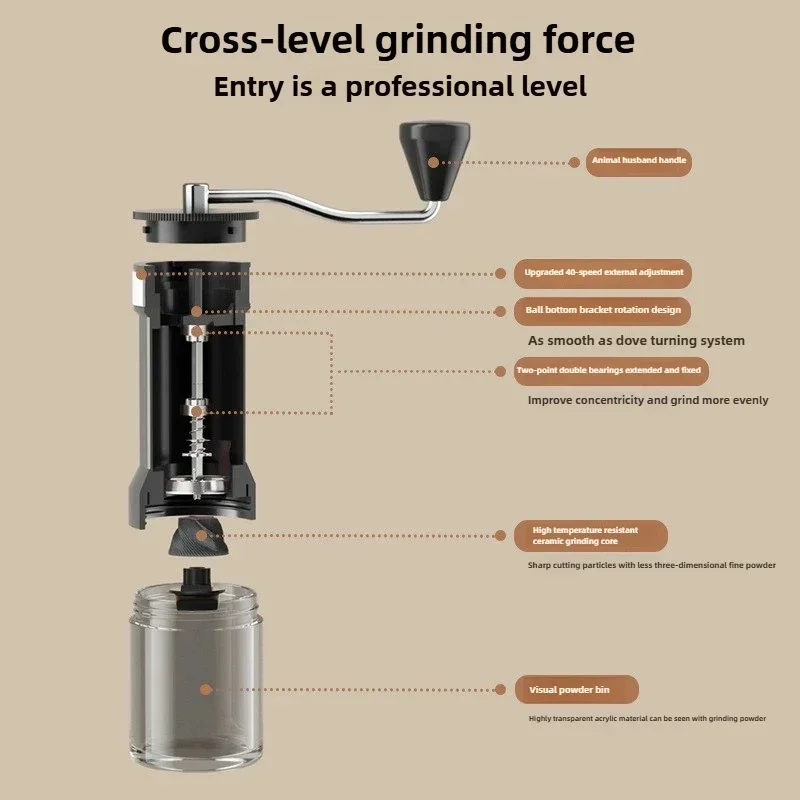
Not every traveler needs or wants to invest heavily in coffee equipment. For those who travel occasionally or are just beginning their fresh-ground coffee journey, several affordable options offer decent performance at entry-level prices under $50.
JavaPresse Manual Grinder
The JavaPresse has become one of the most recognizable budget coffee grinders, featuring a slim stainless steel body and removable handle design that optimizes packability.
Pros:
– Very affordable ($25-30)
– Slim, lightweight stainless steel construction
– Detachable handle improves packability
– 18 grind settings accommodate various brewing methods
– Ceramic burr design rather than cheaper blade mechanism
Cons:
– Inconsistent grind production, particularly at coarser settings
– Slower grinding requires more effort than higher-end models
– Handle connection can wear over time
– Limited capacity (around 20g)
– Adjustment can drift during use
Hario Mini Slim
Hario, a respected name in coffee equipment, offers this compact grinder as an entry point for budget-conscious travelers who still value brand reliability.
Pros:
– Lightweight design at under 12 ounces
– Hexagonal shape prevents rolling on surfaces
– Clear grounds chamber lets you monitor progress
– Ceramic burrs provide adequate performance for medium grinds
– Reasonably durable construction for the price
Cons:
– Plastic body less durable than metal alternatives
– Limited adjustment precision
– Inconsistent grounds, especially at fine settings
– Capacity limited to about 24g
– Requires more cranking effort than premium models
Hario Skerton Pro
The larger sibling to the Mini Slim, the Skerton Pro offers improved stability and capacity while remaining relatively affordable.
Pros:
– Larger capacity (up to 100g) reduces need for multiple grinds
– Glass grounds container provides static-free collection
– Improved burr stabilization system over previous versions
– Rubber base provides stability during grinding
– More ergonomic grinding experience
Cons:
– Less packable than truly portable options
– Glass component adds fragility concern for travelers
– Consistency still lacks compared to mid-range options
– Adjustment system can be confusing initially
– Heavier than dedicated travel options
These general hand coffee grinders represent good starting points for travelers who want the benefits of freshly ground coffee without significant investment. They perform best with medium grind sizes used for methods like pour-over, AeroPress, and drip brewing, though they struggle more with the consistency needed for espresso or the uniformity required for French press.
For occasional travelers or those testing whether grinding fresh makes enough difference to their travel coffee experience to justify a higher investment, these budget options provide a reasonable entry point. Many coffee enthusiasts start with these more affordable grinders before eventually upgrading to mid-range or premium options as they develop more refined preferences.
Portable Electric Grinders: Convenience on the Road
While manual grinders dominate the travel coffee scene, portable electric grinders have carved out their own niche, offering an appealing alternative for certain types of travelers. These battery-powered devices prioritize convenience and reduced physical effort while still delivering freshly ground coffee.
The primary advantage of portable electric grinders is obvious: they eliminate the manual labor of grinding. What might take 2-3 minutes of cranking by hand can be accomplished in 30 seconds or less with an electric motor. This speed and convenience can be particularly valuable when brewing for multiple people or when you simply want the most effortless coffee routine possible.
Most modern portable electric grinders feature rechargeable batteries with USB charging capabilities, making them compatible with power banks, laptop ports, and standard phone chargers. Better models can typically grind 5-8 batches on a single charge, sufficient for several days of moderate coffee consumption.
However, electric travel grinders come with distinct limitations. They’re generally larger and heavier than their manual counterparts, adding more bulk to your luggage. The inclusion of motors, batteries, and electronic components also introduces more potential failure points in challenging travel conditions. Additionally, they operate more loudly than manual alternatives, which may be problematic in shared accommodations.
Electric grinders make the most sense for specific travel scenarios: car camping trips where weight and size constraints are less restrictive, extended stays in single locations like vacation rentals, or digital nomads who have established temporary home bases. They’re also excellent options for travelers with mobility issues or hand strength limitations that make manual grinding difficult.
When considering electric versus manual coffee grinders for travel, the decision ultimately comes down to your priorities: convenience and speed versus reliability and portability. Both approaches can deliver excellent coffee, but they serve somewhat different travel styles and preferences.
Leading Portable Electric Coffee Grinders
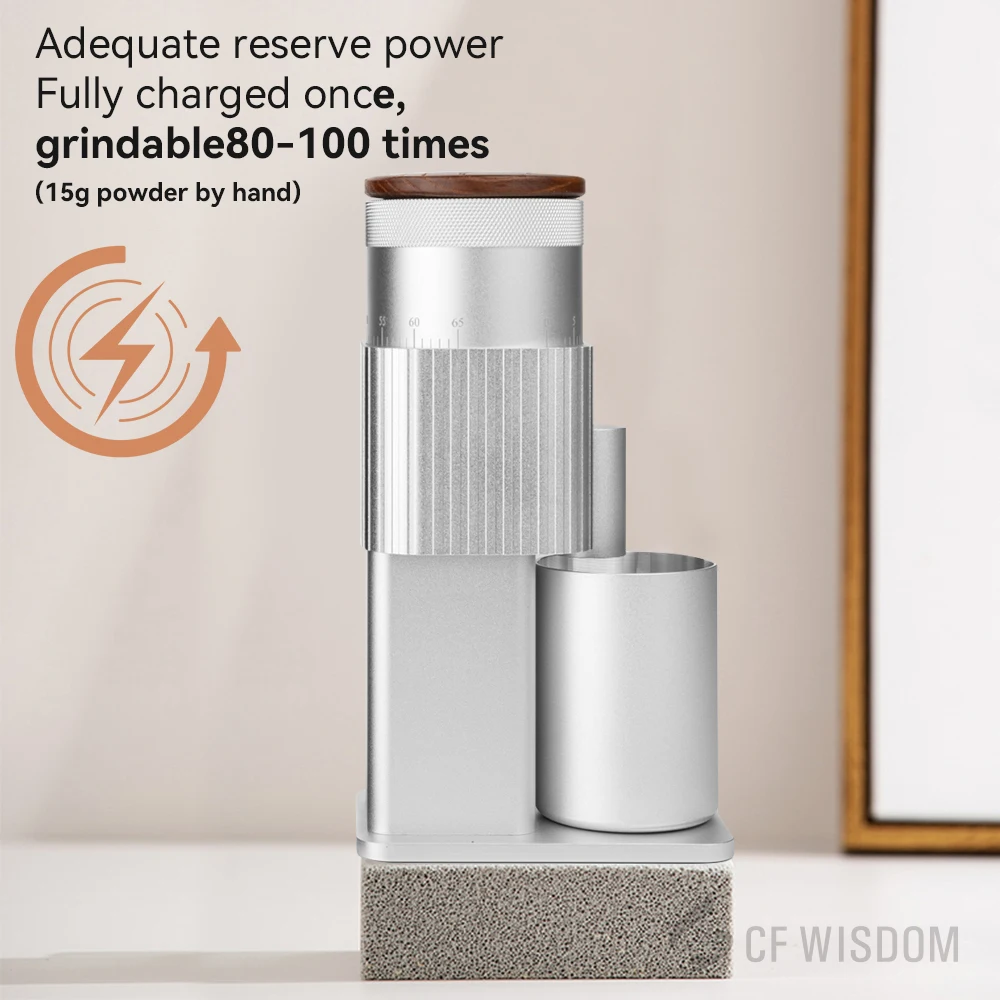
For travelers who prioritize convenience without sacrificing quality, several portable electric grinders stand out from the crowd. These models balance performance, battery life, and relative compactness to deliver fresh grounds with minimal effort.
Lagom Mini
This precision-engineered electric grinder represents the high-end of portable electric options, featuring professional-grade 48mm flat burrs typically found in café-quality equipment.
Pros:
– Exceptional grind consistency rivaling full-sized electric grinders
– Premium construction with aluminum body and stainless steel components
– USB-C rechargeable battery providing 12+ grinds per charge
– Remarkably quiet operation compared to other electric models
– Stepless adjustment allows infinite grind size precision
Cons:
– Premium pricing ($300+)
– Heavier than most travel options at 1.5 pounds
– Larger footprint than manual alternatives
Timemore GO Advanced
Timemore has successfully transferred their design excellence from manual grinders to this compact electric option, creating a streamlined device that balances performance and portability.
Pros:
– Compact design similar in size to larger manual grinders
– USB-C rechargeable battery with 5-6 grinding sessions per charge
– 38mm stainless steel burrs provide consistent grounds
– Clear and precise adjustment system with 30+ settings
– Elegant design with premium materials
Cons:
– Moderate capacity (20-25g) may require multiple grinds
– 3-4 hour full recharge time
– Less robust than manual options for extreme conditions
– Moderate noise level
Staresso Discovery D6E
The Staresso takes an innovative approach as an all-in-one device that not only grinds coffee but can also brew it, offering an extremely compact total coffee solution.
Pros:
– Integrated grinding and brewing system reduces overall packed size
– Ceramic burrs provide adequate consistency for included brewing system
– USB rechargeable with 6-8 grinds per charge
– Ultra-compact multifunctional design
– Can produce espresso-style coffee or regular drip
Cons:
– Jack-of-all-trades approach means grinding is good but not excellent
– Limited capacity for both grinding and brewing
– More complex to clean thoroughly while traveling
– Brewing quality compromises compared to dedicated brewers
Hario Smart G Electric
This entry-level electric option provides a more affordable way to experience the convenience of motorized grinding while traveling.
Pros:
– More accessible price point than other electric options
– Simple one-button operation
– Transparent design lets you monitor grinding progress
– USB rechargeable with modest battery life
– Compact size similar to manual options
Cons:
– Less consistent grind quality, especially at coarser settings
– Slower grinding speed than premium electric models
– Basic construction with more plastic components
– Limited grind adjustment range
– Louder operation than higher-end alternatives
These electric options have particular appeal for portable coffee grinders for camping when car camping or traveling by vehicle where space constraints are less restrictive. The convenience of push-button grinding makes morning coffee routines significantly faster, particularly when brewing for multiple people.
Fine Adjustment Hand Grinder, Precision Manual Grinder, Travel Coffee Grinder
Price range: $185.11 through $494.63 Select options This product has multiple variants. The options may be chosen on the product pageHand Burr Grinder, Hand Crank Coffee Grinder, Manual Espresso Grinder, Portable Coffee Grinder
Price range: $262.72 through $300.22 Select options This product has multiple variants. The options may be chosen on the product pageManual Burr Mill, Manual Coffee Grinder Stainless Steel, Manual Coffee Mill Grinder, Mechanical Coffee Grinder
Price range: $127.26 through $130.32 Select options This product has multiple variants. The options may be chosen on the product pageHand Burr Grinder, Manual Coffee Grinder Stainless Steel, Precision Manual Grinder
Price range: $183.64 through $187.52 Select options This product has multiple variants. The options may be chosen on the product page
For travelers whose priorities include speed, convenience, and reduced physical effort, these electric grinders provide excellent alternatives to manual options, though they do require access to electricity at least every few days to recharge.
Manual vs. Electric: Choosing the Right Travel Grinder
When deciding between manual and electric travel grinders, several key factors will help determine which option better aligns with your specific travel style and coffee preferences.
| Factor | Manual Grinders | Electric Grinders |
|---|---|---|
| Portability | Typically smaller and lighter (8-16 oz) | Larger and heavier (16-24 oz) |
| Power Independence | No power required | Needs recharging every 5-8 uses |
| Grind Consistency | Excellent in premium models | Very good but can vary by price point |
| Effort Required | 1-3 minutes of physical cranking | Push-button convenience |
| Durability | Highly durable with few failure points | More potential failure points |
| Noise Level | Relatively quiet | Moderate to loud |
| Price Range | $25-250 | $50-350 |
| Maintenance | Simple cleaning, few parts | More complex with electronic components |
Manual grinders clearly excel for ultralight backpacking, wilderness travel, or any scenario where power access is limited or unpredictable. Their reliability, quieter operation, and generally smaller form factor make them ideal for minimalist travelers who don’t mind the additional effort and time required for grinding.
Electric grinders, meanwhile, are better suited for road trips, car camping, extended stays in single locations, or travelers with physical limitations. Their convenience and speed significantly streamline the coffee-making process, particularly when brewing for groups.
Your brewing method also influences this decision. For espresso enthusiasts, premium manual grinders often provide better consistency and pressure control than all but the most expensive portable electric options. Conversely, if you’re primarily brewing larger batches with methods like French press or pour-over, the speed of electric grinding becomes more valuable.
Understanding the differences between burr and blade grinders is also crucial regardless of power source. Burr grinders consistently outperform blade grinders in terms of grind quality and consistency, which significantly impacts extraction quality. While most quality travel grinders use burr mechanisms, it’s an important distinction when evaluating budget options.
Ultimately, the right choice depends on honestly evaluating your travel patterns, brewing needs, and which compromises you’re most willing to accept. Many serious coffee travelers eventually own both types, using each for different journey styles.
How to Choose Your Perfect Travel Coffee Grinder: A Buyer’s Guide

Finding your ideal travel grinder requires understanding both your coffee needs and travel style. This step-by-step approach will help narrow your options to the perfect match:
Step 1: Identify Your Primary Brewing Method
Different brewing methods require different grind consistencies and levels of precision:
– Espresso: Requires extremely consistent fine grinds. Consider premium manual grinders or high-end electric options with quality burrs.
– AeroPress/Pour-over: More forgiving but benefits from consistency. Mid-range grinders perform adequately here.
– French Press: Needs consistent coarse grounds. Avoid budget manual grinders, which often struggle with coarse consistency.
Step 2: Assess Your Travel Patterns
Your typical travel style significantly impacts which grinder features matter most:
– Ultralight Backpacking: Prioritize minimum weight and size. Consider the most compact manual options.
– International Travel: Focus on durability and power independence. Manual grinders eliminate adapter concerns.
– Road Trips/Car Camping: Size and weight constraints are reduced. Electric options become more practical.
– Business Travel: Consider noise levels and packability in formal luggage. Slim manual grinders or quiet electric options work well.
Step 3: Evaluate Space and Weight Constraints
Be honest about your luggage limitations:
– How much space can you realistically allocate to coffee equipment?
– Is saving a few ounces critical, or is size more important than weight?
– Will the grinder need to fit inside other equipment (like an AeroPress)?
Step 4: Consider Power Availability
For electric options, think through your access to charging:
– Will you have reliable access to power every few days?
– Do you already carry a power bank that could charge your grinder?
– Are you traveling to regions with reliable electricity?
Step 5: Determine Your Budget
Quality grinders exist across price ranges, but with different trade-offs:
– Budget ($20-50): Acceptable performance with compromises in consistency and durability
– Mid-range ($50-100): Good performance suitable for most brewing methods
– Premium ($100-250+): Exceptional consistency and construction rivaling home grinders
Step 6: Assess Capacity Needs
Consider how much coffee you typically brew:
– Solo traveler making single cups: Smaller capacity (15-20g) is sufficient
– Brewing for multiple people: Larger capacity (30g+) or acceptance of multiple grinding sessions
Compact coffee mills offer various capacity options, but generally, as capacity increases, so does size and weight. Be realistic about your typical usage rather than occasional maximum needs.
When evaluating specifications, focus on burr material and design, adjustment mechanism precision, and construction materials at connection points, which receive the most stress during grinding. Read reviews focusing specifically on travel use rather than home use, as priorities differ significantly.
For travelers with minimal space concerns, maximizing flavor in minimal space still requires making smart choices about which features truly matter for your specific coffee preferences and travel style.
Pro Tips for Grinding Coffee While Traveling
Traveling with a coffee grinder requires some adaptations to your normal coffee routine. These expert tips will help you get the most from your travel grinding setup:
Perfect Your Packing Strategy
Protect your grinder by nesting it inside soft items like socks or t-shirts. For premium grinders, consider dedicated protective cases or repurposing hard sunglasses cases. Remove handles from manual grinders and store them separately to prevent stress on connection points.Pre-Weigh Your Beans
Small plastic containers or reusable silicone bags pre-filled with single-serving portions of beans (typically 15-20g) eliminate the need for a scale while traveling. This both speeds up your brewing process and ensures consistent results each time.Master Environmental Adaptations
High altitude locations may require slightly coarser grinds as water boils at lower temperatures. Similarly, very humid environments can affect bean moisture and grinding resistance. Be prepared to adjust your usual settings by 1-2 clicks finer or coarser depending on conditions.Develop Travel-Specific Cleaning Routines
When full disassembly isn’t practical, keep your grinder clean by carrying a small brush for quick burr cleaning. Grinding a few grains of uncooked rice or a small piece of bread can help remove oils and fine particles when thorough cleaning isn’t possible.Minimize Noise in Shared Spaces
When using your grinder in hotel rooms or hostels, place a folded towel underneath to dampen vibrations and sound. For manual grinders, holding the body against a soft surface like a pillow while grinding can significantly reduce noise transmission.Perfect Your Bean Storage System
Small mason jars, purpose-made coffee vaults, or vacuum-sealed bags can extend bean freshness during travel. Always choose containers that block light and provide an airtight seal. For extended trips, consider dividing your beans into smaller portions so only what you need is exposed to air.Improvise When Necessary
If your grinder fails or gets lost, look for local coffee shops that might grind beans for you, or explore alternative brewing methods that can work better with pre-ground coffee, such as immersion brewing techniques.
The complete guide to portable coffee mills offers additional insights for troubleshooting common issues travelers encounter. With practice, you’ll develop a streamlined travel coffee routine that delivers excellent results with minimal fuss, regardless of your destination.
When Grinding Isn’t Practical: Alternative Travel Coffee Solutions
Even the most dedicated coffee enthusiasts occasionally encounter situations where grinding fresh isn’t feasible. Whether due to extreme space limitations, very short trips, or activities where every ounce and cubic inch matters, these alternative solutions can help maintain decent coffee quality:
Strategic Use of Pre-Ground Coffee
For short trips (3 days or less), properly handled pre-ground coffee can maintain acceptable quality:
– Grind immediately before departure using your home grinder
– Store in completely airtight containers with one-way valves
– Package in single-serving portions to minimize air exposure
– Consider slightly finer grinds than normal to compensate for flavor loss
Specialty Instant Coffee
Modern specialty instant coffees have dramatically improved in quality:
– Companies like Swift Cup, Voilà, and Sudden offer freeze-dried specialty coffee
– These products capture significantly more complexity than traditional instant coffees
– They’re incredibly lightweight and require only hot water
– No equipment needed beyond a cup, making them ideal for ultralight activities
– While not identical to freshly ground coffee, they offer impressive flavor profiles
Coffee Concentrates and Liquid Solutions
Pre-made coffee concentrates can provide quality with minimal equipment:
– Cold brew concentrates can last 1-2 weeks refrigerated or several days unrefrigerated
– Liquid coffee shots like Cometeer (frozen coffee extract pods) offer consistent quality
– These options only require dilution with hot or cold water
Coffee “Tea Bags”
Pre-packed steeped coffee products offer a middle ground:
– Products like Coffeebrewers by Grower’s Cup or Dripkit provide pre-measured ground coffee in pour-over style packages
– These maintain reasonable freshness through special packaging
– They require only hot water and a cup
– Quality tends to surpass traditional instant coffee but falls short of freshly ground options
When selecting alternatives, consider the specific demands of your trip. Ultra-lightweight backpacking might make specialty instant the clear choice, while road trips might allow for pre-ground coffee with an appropriate brewer.
Different brewing methods also handle pre-ground coffee with varying success. Immersion methods like French press and AeroPress tend to be more forgiving with pre-ground coffee than pour-over methods, which more readily reveal staleness through uneven extraction.
Understanding these options ensures you can select the best coffee brewing method for travel based on your specific constraints, helping maintain your coffee ritual even when grinding fresh isn’t practical.
Is Pre-Ground Coffee Ever a Good Option for Travelers?

While freshly ground coffee provides the optimal flavor experience, there are indeed scenarios where pre-ground coffee makes practical sense for travelers. The key is understanding when this compromise is acceptable and how to minimize quality loss.
Pre-ground coffee becomes a reasonable option during ultra-short trips lasting 1-3 days. The deterioration timeline of ground coffee is progressive, not immediate. While aromatics begin diminishing within minutes, coffee ground immediately before your departure and properly stored will still taste noticeably better on day two or three than coffee that was ground weeks earlier at a factory.
Extreme space or weight constraints might also justify pre-ground coffee. For activities like ultralight backpacking, alpine climbing, or motorcycle touring, every cubic inch and ounce matters. In these scenarios, the space saved by omitting a grinder might allow you to carry a better brewing device or simply lighten your load.
To maximize pre-ground coffee quality while traveling:
Use specialty-grade beans with distinctive flavor profiles, as these retain more character even after some degradation.
Grind immediately before departure using your home grinder at the appropriate size for your travel brewing method.
Package properly in small, airtight containers with one-way valves. Commercial options like Airscape Go or simple solutions like small mason jars work well. Divide your coffee into daily portions to minimize air exposure.
Consider vacuum-sealing individual portions for trips longer than 3-4 days, opening each packet only when needed.
Slightly adjust your brewing parameters by using water just off boil and possibly extending brew time by 10-15% to compensate for reduced aromatic compounds.
While these strategies won’t completely match freshly ground coffee, they can produce a cup that’s significantly better than typical pre-ground options. For many travelers, this middle-ground approach represents a practical compromise between perfect coffee and travel reality.
How Much Should You Spend on a Travel Coffee Grinder?
The question of budget is always personal, but understanding what you get at different price points can help you make an informed decision about your travel coffee grinder investment.
Budget Range ($20-50)
At this price point, expect functional but basic performance:
– Adequate grind consistency for less demanding brewing methods like French press or drip
– Primarily ceramic burrs, which perform acceptably but wear faster than steel
– Mostly plastic components with limited durability under travel stress
– Basic adjustment mechanisms with fewer grind settings
– Slower grinding with more physical effort required
– Acceptable for occasional travelers or those just starting their coffee journey
Mid-Range ($50-100)
This sweet spot offers significant improvements over budget options:
– Noticeably better grind consistency suitable for most brewing methods including pour-over
– Steel burrs in many models, offering better longevity and precision
– Mixed construction with more metal components at stress points
– More sophisticated adjustment mechanisms with additional settings
– Improved efficiency for faster, easier grinding
– Excellent value proposition for regular travelers who appreciate good coffee
Premium ($100-250+)
The high-end category delivers performance that rivals home equipment:
– Exceptional grind consistency comparable to commercial-grade equipment
– Professional-quality burrs made from hardened steel or other premium materials
– All-metal construction designed for years of heavy use
– Precise adjustment mechanisms with numerous clearly defined settings
– Remarkably efficient grinding with minimal effort
– Investment-grade tools that can last 5+ years with proper maintenance
When determining your appropriate budget, consider how frequently you travel and how important coffee quality is to your overall experience. For someone who travels monthly and considers good coffee an essential part of their routine, a mid-range or premium grinder might amortize to just dollars per trip while significantly enhancing the experience.
Proper maintenance of manual coffee grinders also affects long-term value. Higher-end grinders typically feature serviceable designs where individual parts can be replaced rather than requiring complete replacement if something breaks. This serviceability often makes premium grinders more economical over their total lifespan despite higher initial costs.
For most regular travelers who value coffee quality, the mid-range category offers the best balance of performance and value, while premium options make sense for those who travel frequently or demand the very best cup regardless of location.
Can Travel Coffee Grinders Deliver the Same Quality as Home Grinders?
This question gets to the heart of what many coffee enthusiasts worry about when considering travel options. The answer is nuanced but encouraging: top-tier travel grinders can indeed approach or even match home grinder quality, but with some important qualifications.
Premium manual travel grinders like the 1Zpresso K-Ultra or Comandante C40 feature professional-grade burrs that produce grind consistency comparable to electric home grinders costing twice as much. Blind taste tests conducted by coffee professionals have repeatedly shown that these high-end portable grinders can produce grounds that yield exceptional extraction and flavor clarity.
The primary technical differences between travel grinders and home models include:
Burr Size and Design – Home grinders typically feature larger burrs (50-70mm vs. 38-48mm in portables), which can grind faster and potentially generate less heat. However, the quality of the burrs often matters more than size alone.
Stability During Grinding – Home grinders benefit from weight and wider bases, creating greater stability. Premium travel grinders compensate with precision-machined components and robust bearing systems that minimize burr wobble.
Adjustment Precision – High-end home grinders may offer more granular adjustment, though premium travel options like those with fine adjustment hand grinder capabilities now feature comparable adjustment systems with 30+ distinct settings.
Grinding Speed – Electric home grinders are unquestionably faster, especially when preparing coffee for multiple people. This represents perhaps the biggest practical difference for many users.
In practical terms, the gap is most noticeable at the extremes of the grind spectrum. For espresso, where ultra-fine and perfectly consistent grounds are crucial, only the very best travel grinders can match dedicated home espresso grinders. Similarly, for very coarse settings used in cold brew, some travel grinders produce more “fines” (too-small particles) than specialized home equipment.
For the vast middle range covering pour-over, AeroPress, and even most French press brewing, premium and even good mid-range travel grinders perform excellently. Many coffee enthusiasts report being unable to distinguish between coffee prepared with grounds from their premium travel grinder versus their home electric model in blind tasting.
The most significant practical difference usually isn’t quality but convenience. Hand grinding takes more time and effort, especially when preparing coffee for multiple people. This represents a trade-off that travelers must evaluate based on their specific needs and preferences.

